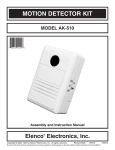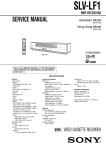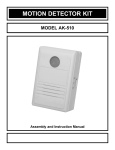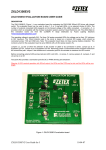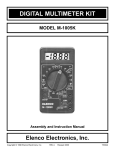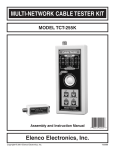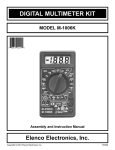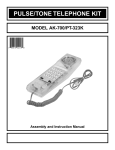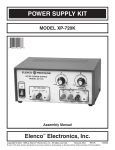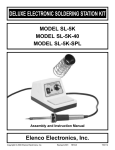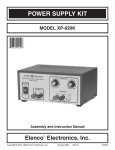Download Elenco Electronics AR-2N6K Instruction manual
Transcript
FM RECEIVER KIT MODEL AR-2N6K Assembly and Instruction Manual Copyright © 2003, 1995 Electronics, Inc. Revised 2003 REV-D 753001 PARTS LIST If you are a student, and any parts are missing or damaged, please see instructor or bookstore. If you purchased this FM receiver kit from a distributor, catalog, etc., please contact Elenco Electronics (address/phone/e-mail is at the back of this manual) for additional assistance, if needed. TM RESISTORS Qty. 1 1 2 2 2 1 1 1 1 1 1 2 Symbol R9 R15 R10, R12 R3, R7 R4, R6 R8 R11 R5 R2 R1 VR2 VR1, VR3 Value 0Ω 10Ω 5% 1/4W 1kΩ 5% 1/4W 3.3kΩ 5% 1/4W 4.7kΩ 5% 1/4W 8.2kΩ 5% 1/4W 10kΩ 5% 1/4W 20kΩ 5% 1/4W 47kΩ 5% 1/4W 68kΩ 5% 1/4W 5kΩ 20% linear 100kΩ knurl shaft Color Code Jumper Wire (use a discarded resistor lead) brown-black-black-gold brown-black-red-gold orange-orange-red-gold yellow-violet-red-gold gray-red-red-gold brown-black-orange-gold red-black-orange-gold yellow-violet-orange-gold blue-gray-orange-gold Qty. 1 1 1 1 1 1 1 1 Symbol C5 C8 C6 C6A C17 C12 C1 C7 Value 3.9pF Discap 7pF 20% 25V 33pF 10% 50V Disc 39pF 51pF 10% 68pF 10% 120pF 470pF 10% 50V Disc Marking 3.9 7 33 39 51K 68K 121 471 Qty. 2 1 1 1 Symbol D1, D2 U2 U1 U3 Value Diode 1N914 IC LM386N-1 Audio Amp IC MC3362P FM Receiver IC 78L05 Regulator +5V Qty. 1 2 1 1 1 1 1 1 3 1 4 1 2 1 1 1 Symbol Description PC Board Switch Slide DPDT Filter Ceramic 10.7MHz Filter Ceramic 455kHz Crystal 10.245MHz Battery Snap 9V Battery Holder 9V Speaker 8Ω Bracket L-shaped Front Panel Nylon Clips Phono Plug Knob Push-on Knob Large Phono Jack Case Plastic Part # 203921 207000 213317 213917 215110 216816 221280 224717 Qty. 1 1 3 1 6 2 1 Symbol C10 C2 C11,C13,C16 C22 C3,C4,C9 C18,C19,C20 C14, C21 C15 Part # 121000 141000 143300 144700 148200 151000 152000 154700 156800 192450 192614 Value 1000pF 10% 50V .005µF 20% 25V .01µF +80, –20% .047µF +80, –20% 50V .1µF +80, –20% 50V Marking 102 502 or .005 103 473 104 Part # 231035 235025 241031 244780 251010 4.7µF 50V Radial 220µF 16V Radial 4.7µF 50V 220µF 16V 264747 282244 SEMICONDUCTORS Marking 1N914 LM386N-1 MC3362P 78L05 Part # 310914 330386 333362 338L05 Qty. 1 1 1 2 Symbol L4 L1 L5 L2, L3 Value Coil (1.5 turns coated wire) Coil (4.5 turns coated wire) Coil (metal can yellow) Coil (on form with core) Part # 430170 430180 430260 468752 Description Alignment Tool Screw 2-56 x 1/4” Screw 4-40 x 1/4” Nut 7mm Hex Nut 2-56 Hex Nut 4-40 Hex Flat Washer Lock Washer 5/16” internal tooth Lock Washer #4 internal tooth IC Socket 8-pin IC Socket 24-pin narrow Tape Double-sided Foam Wire #22 Solid Orange 84” Cable Shielded 2-conductor Solder Tube Part # 629011 641237 641433 644101 644201 644400 645101 646101 646401 664008 664025 740004 814320 876090 9ST4 MISCELLANEOUS SW1, SW2 F2 F1 Y1 SPK Part # 517021 541021 560107 560455 561024 590098 590099 590102 613000 614107 621012 621017 622009 622080 622103 623240 Qty. Symbol 1 4 3 3 4 3 3 3 3 1 1 1 1 1 1 -1- THE AR-2N6 3. Specifications and testing procedure for each circuit. It is the goal of this project to educate the builder in all of the principles needed to design and build this kit. The radio is broken down into four blocks. Each block contains: 4. Troubleshooting guide for each circuit. 5. Quiz on circuit (answers included). 1. Explanation of circuit to be assembled (Theory of Operation). A final quiz is included (with answers) to help demonstrate the overall knowledge gained by building this kit. With this in mind, let’s start by defining exactly what this radio kit is. 2. Detailed assembly instructions for each circuit. The AR-2N6 is a dual conversion narrow band FM radio receiver designed to detect signals in the 2 meter and 6 meter bands. Dual Conversion The original radio frequency in converted first to a 10.7MHz intermediate frequency (i-f) and amplified (Block 4). The 10.7MHz signal is then converted to 455kHz and amplified (Block 3). Noise is removed and the modulated signal is recovered from the 455kHz i-f signal (Block 2). The audio signal is amplified to drive a speaker (Block 1). Antenna Speaker CONVERT TO 10.7 AND AMPLIFY CONVERT TO 455 AND AMPLIFY REMOVE NOISE & DEMODULATE BLOCK 4 BLOCK 3 BLOCK 2 AUDIO AMP BLOCK 1 Figure 1 Why Convert Twice? In the attempt to obtain the desired intermediate frequency (i-f) signal by mixing the local oscillator with the desired radio frequency, an unwanted output may result due to a transmission spaced one intermediate frequency (i-f) on the opposite side of the oscillator (image). By using a large i-f frequency, this image is moved further out of the band of desired frequencies. The second conversion provides the selectivity to filter out the desired narrow band transmission. Desired Band of Frequencies Desired Frequency Local Oscillator Image Frequency SECOND CONVERSION TO 455kHz Crystal Oscillator at 10.245 Desired Band of Frequencies Local Oscillator #1 Desired Frequency Image Frequency 10.7MHz 10.7MHz Single Conversion with 455kHz Intermediate Frequency Double Conversion puts the Image Outside of Desired Band and still allows Narrow Band Output Figure 2 -2- Narrow Band The selectivity of the entire system is limited to only enough frequencies to pass voice or low frequency data. A normal FM receiver would have a bandwidth large enough to pass music and high frequency data transmissions. Narrow Band Wide Bandwidth 3kHz 200kHz Figure 3 FM Radio Receiver The letters “FM” stand for Frequency Modulation. The other popular forms of modulation are AM (Amplitude Modulation) and PM (Phase Modulation). Frequency modulation means the data or voice changes the frequency of the radio wave. Frequency Modulation Amplitude Modulation Figure 4 2 Meter Band If the speed of a wave (meters per second) is divided by the number of waves that pass a given point (cycles per second), the seconds cancel and you obtain the wavelength (λ = meters per cycle). The speed of radio waves is approximately 300,000,000 meters per second. If the frequency is 150MHz, the wavelength becomes 300,000,000/150,000,000 or 2 meters. 6 Meter Band To find the frequency in MHz, divide the speed in millions of meters per second by the wavelength in meters. A 6 meter wave has a frequency of 300/6 or 50MHz. 2 Meters 6 Meters 150MHz 50MHz Figure 5 Actual bands are: 2 Meter covers 144MHz to 148MHz. 6 Meter covers 50MHz to 54MHz. All licensees, except Novices, are allowed to use these bands. -3- BLOCK 1 - THE AUDIO AMPLIFIER THEORY OR OPERATION The audio in this radio is amplified by using an integrated circuit audio power amplifier. The LM-386 specifications are as follows: The output impedance of the amplifier is low enough to drive an 8Ω speaker directly. The coupling capacitor value is picked to pass audio signals down to 100 cycles by matching the reactance of the capacitor with the speaker impedance. In other words, 8Ω = 1/2πfC, where f = 100Hz. By solving for C we get: • • • • • • • • Single supply voltage (4-12V) Idle current - 4 milliamps Inputs referenced to ground Input resistance - 50kΩ Self-centering output voltage Total harmonic distortion less than 0.2% Output power with 9 volt supply voltage Voltage gain with 10µF from pin 1 to 8 - 200 or 46dB • Voltage gain with pins 1 and 8 open - 20 or 26dB • Bandwidth with pins 1 and 8 open - 300kHz C C C C = = = = 1/(2πf)(8Ω) 1/(6.28)(100)(8) 1/5026 0.00019896 or C ≈ 200µF (220µF used) Due to the high input resistance of the amplifier (50kΩ), the audio coupling capacitor C3 can be as small as 0.1µF. The equivalent resistance at the junction of R8 and VR3 is approximately 6.6kΩ (the parallel combination of R8, VR3 and the 50kΩ input impedance of the LM-386). The capacitor C2 and this equivalent resistance sets the 3dB corner used to attenuate any IF voltage at pin 13. A simple RC filter attenuates at a rate of 6dB per octave (an octave is the same as doubling the frequency). By using 6.6kΩ as the equivalent resistance and 0.005µF as the capacitance, we get a 3dB corner at approximately 4.8kHz. To get to 455kHz, you must double 4.8kHz approximately 6.6 times. This equates to a reduction of the IF voltage at the R8 VR3 junction of 39.6dB (6dB per octave times 6.6 octaves), or 95 times. LM-386 Audio Amplifier R8 = 8.2kΩ Pin 13 Detector Output C2 = 0.005µF Pin 11 Carrier Detect VR3 = 100kΩ R12 = 1kΩ C1 = 220µF C3 = 0.1µF Figure 6 -4- 8Ω ASSEMBLY INSTRUCTIONS FOR BLOCK 1 Solder the parts to the PC board and put a check mark in the box (!) next to each step after it is completed. The parts should be similar to the sketch in each box, but will differ in size. Be sure to check each solder point for shorts and cold solder connections. Be careful to prevent static discharge when handling integrated circuits U2 and U3. Insert the IC socket into the PC board with the notch in the same direction as the marking on the PC board. Notch 104 C3 - .1µF Capacitor C4 - .1µF Capacitor Insert the LM-386 IC into the IC socket with the notch in the same direction as the notch on the socket. PC Board Marking C15 - 220µF Lytic Polarity Mark (–) (+) R8 - 8.2kΩ Resistor (gray - red - red - gold) Figure 7 C14 - 4.7µF Lytic U3 - 78L05 Voltage Regulator Bend the leads as shown and make sure that the flat side matches the PC board marking. C21 - 4.7µF Lytic Polarity Mark (–) (+) Flat Side -5- R12 - 1kΩ Resistor (brown - black - red - gold) CONNECTING PARTS TO THE BACK SIDE OF THE PC BOARD Twist two leads of a 10Ω resistor and a .047µF capacitor as shown in Figure 8a. Solder the wires close to the components and clip off any excess wire. Solder 473 C22 - .047µF Capacitor (473) R15 - 10Ω Resistor (brown-black-black-gold) Figure 8a Mount the components shown in Figure 8 to the foil side of the PC board. Place a check mark in the box (!) after each part is in place. 502 C2 - .005µF Capacitor (502) C2 - .047µF Capacitor (473) 473 R15 - 10Ω Resistor (brown-black-black-gold) Figure 8 -6- CONNECTING THE FRONT PANEL PARTS TO THE PC BOARD Solder the parts to the PC board and put a check mark in the box (!) next to each step after it is completed. The parts should be similar to what is shown in Figure 9. To wire the speaker, pot and switch, cut the indicated length of wire from the roll of 22 gauge solid wire and strip 1/4” of insulation off of each end. Before soldering, mechanically connect the wire to the parts as shown in the figure. For the jumper wire, cut 2” of 22 gauge solid wire, strip 1/4” of insulation off of each end and solder to the points indicated. Figure 9 _ + Incorrect Correct (Lead too long) Speaker Leads - 4” wires Battery Snap ON/OFF Switch Attach the wires to the switch and points A & B on the PC board as shown. Tab VR3 - 100kΩ Volume Control Attach the wires to points C, D, & E on the PC board. Cut off tab on the pot. 4” Jumper Wire (temporary) Make a good mechanical connection before soldering. -7- 3” TEST PROCEDURE - BLOCK 1 Procedure 1 If you do not have an audio generator and multimeter, skip to procedure 2. and connect to the circuit as shown in Figure 10. Connect the positive voltage probe to the positive lead of capacitor C4. Connect the common probe to the negative lead from the battery. Turn the power ON. The multimeter should read between 4.5V and 5.5V. If not, turn off the power and check that U3 is correctly installed. Also, check for solder shorts and unsoldered leads. Power Test Make sure that the power switch is in the OFF position (handle away from the 2 wired terminals). Connect a fresh 9V alkaline battery to the battery snap. Set the multimeter to read on the 20V scale Temporary Connection V 20A COM A Ω VΩ 9V Battery Figure 10 Audio Gain multimeter for the best reading and record here: Input Voltage = ___________________ The gain is the output voltage divided by the input voltage. Since the output voltage was set at 2V, the gain is equal to 2 divided by the reading recorded above. Gain should be approximately equal to 17. If gain test fails, turn off the power and check the connections on all external parts. Check for shorts between pins on IC U2 and make sure that all of the IC pins are properly inserted in the socket. Replace the battery with a fresh alkaline battery. Make sure that the power switch is in the OFF position. Connect the audio generator and multimeter as shown in Figure 11. Turn the volume control fully clockwise (maximum gain). Put the multimeter in the AC 20V position, turn the generator to minimum at 400Hz sine wave output, and turn the power ON. Slowly increase the generator output until the multimeter reads 2Vrms. Move the multimeter lead to the generator output as shown by the dashed lines in Figure 11. Adjust the -8- 455kHz V 20A COM A Ω VΩ 9V Battery Figure 11 Power Output Multiply the peak by 0.707 and square the result. Divide by 8Ω (speaker impedance) to obtain the maximum power output before clipping distortion occurs. Maximum power output should be 1/2W or greater. If this test fails, replace the battery with a power supply capable of delivering 1/2A @ 9V or replace the battery with a fresh alkaline battery. If you do not have an audio generator and an oscilloscope, skip this test. Make sure that the power is OFF and connect the audio generator and the oscilloscope as shown in Figure 11 (replace the multimeter leads with scope leads). Set the generator to 400Hz minimum output and set the oscilloscope to read 1V/div. Put the volume control in the fully clockwise position. Turn the power ON and set the audio generator output until a waveform similar to the one shown in Figure 12 is obtained. The flat area indicates clipping. You may have to adjust the oscilloscope time base for correct comparison. Measure the peak to peak voltage at which the clipping first occurs and record here: Example If the peak to peak voltage - 5.66 Peak Voltage - 5.66 x 0.5 or 2.83 rms Voltage - 2.83 x 0.707 = 2.0 rms Voltage Squared - 2 x 2 = 4 Dividing by speaker impedance of 8Ω gives a power of 0.5W. Peak to Peak Reading = __________________ The power output before clipping is equal to the square of the rms voltage across the speaker divided by the speaker impedance. The rms voltage for a sine wave is equal to the peak voltage times 0.707. To get the peak voltage, divide the peak to peak reading recorded above by 2. Figure 12 Peak to Peak Flat Area -9- Frequency Response If you do not have an audio generator and an oscilloscope, skip this test. Make sure that the power is OFF and connect the audio generator and the oscilloscope as shown in Figure 11 (replace the multimeter leads with scope leads). Set the generator to 400Hz minimum output and set the oscilloscope to read 1V/div. Put the volume control in the fully clockwise position. Turn the power ON and adjust the audio generator output until a waveform similar to the one shown in Figure 13 is obtained. You may have to adjust the oscilloscope time base for correct comparison. Without changing the generator output level, slowly lower the frequency of the audio generator until the sine wave at the speaker falls to 0.707 of the original setting (3dB point or 1/2 power point). Record that frequency here: During this second measurement, the voltage at the speaker may go higher than the original value due to speaker resonance. The frequency at which a speaker resonates changes with speaker size, mounting method, and speaker enclosure. The bandwidth of your audio circuit is equal to the frequency difference between these 2 half power points and should be no less than 3,000Hz. If you fail this test, check that capacitors C2, C3, and C15 are the proper values and are correctly installed. Speaker Frequency = __________________ Bandwidth = __________________ Example 3dB Point Low Side = 100Hz 3dB Point High Side = 4,000Hz Bandwidth = 4,000 - 100Hz Bandwidth = 3,900Hz Without changing the generator output level, slowly raise the frequency of the audio generator above the original 400Hz until the sine wave at the speaker falls to 0.707 of the original setting and record here: 0.707 of original peak to peak voltage Speaker Frequency = __________________ Original Voltage Figure 13 Procedure 2 If you do not have any test equipment, you can test the audio circuit as follows: The audio should make a buzzing sound. The pitch will change if you vary the volume control setting. If this test fails, turn the power OFF and check for solder shorts between the pins on U2 (LM-386 integrated circuit). Check that all of the parts are the correct value and are installed properly. Check that regulator U3 is installed properly. Make sure that the power switch is turned OFF. Connect a fresh 9V battery to the battery snap. Put the volume control in the mid position. While holding one lead of a 0.1µF capacitor on the R8 resistor lead, place the other lead on the speaker wire marked “+” and turn the power ON (see Figure 14). -10- Feedback Capacitor 104 9V Battery Volume control in mid-position Figure 14 QUIZ 1 1. The impedance of a 200µF capacitor at 100Hz is: (a) 50Ω (b) 79.6Ω (c) 2Ω (d) 7.96Ω 6. The first IF frequency in the AR-2N6 Radio Kit is: (a) 455kHz (b) 10.7MHz (c) 150MHz (d) 50MHz 2. If the frequency is 150MHz, the wavelength is approximately . . . (a) 20 meters (c) 6 meters (b) 2 meters (d) need more information 7. In order to get the second IF frequency, a crystal oscillator must be set at: (a) 455kHz (c) 10.7MHz (b) 545kHz (d) 10.245MHz 3. Frequency modulation means the data or voice changes the . . . (a) amplitude (c) phase (b) frequency (d) power 8. The integrated circuit audio power amplifier used in the AR-2N6 Kit has an input resistance of . . . (a) 50kΩ (b) 5kΩ (c) 8Ω (d) 7.96Ω 9. Resistor R8 and capacitor C2 attached to the audio volume control are used to . . . (a) peak the audio (c) flatten audio response (b) provide bass boost (d) limit the bandwidth 4. The audio in this radio is amplified using . . . (a) an IC audio power amplifier (b) a discrete power amplifier (c) a preamplifier (d) increased bandwidth Answers: 1. d, 2. b, 3. b, 4. a, 5. a, 6. b, 7. d, 8. a, 9. d, 10. c 5. Double conversion is used to . . . (a) remove undesired image (b) reduce noise (c) provide greater gain (d) increase bandwidth 10. When soldering electronic components, always use . . . (a) high wattage iron (c) rosin core solder (b) acid core solder (d) paste flux -11- BLOCK 2 - RECOVERING THE DATA Theory of Operation In dealing with FM receivers, there are some terms that must be defined. First, let’s determine the term deviation as the frequency swing of the incoming FM signal. When no modulation is present, the incoming signal is a fixed frequency carrier wave (Fc). Positive deviation (Fp) is the increase in Fc due to modulation, and negative deviation (Fn) is the decrease in Fc due to the modulation. The detector must be linear over the maximum total deviation (Fp max. - Fn max.) produced by the transmitter or distortion will occur. integrated circuit. A limiting amplifier is designed to remove any amplitude variations in the signal by amplifying the signal well beyond the limit of the amplifier. The frequency variations (FM) are not affected by the limiter. The limiter removes the affects of fading (driving through a tunnel) and impulse noise (lightning and ignition). These affects produce significant unwanted amplitude variations in the received signal, but minor frequency variations. Noise immunity is one of the great advantages of frequency modulation over amplitude modulation. The remaining signal contains only the frequency modulation as shown in Figure 15. Before the second i-f signal reaches the detector, it is applied to a limiting amplifier inside the Original Transmitted Signal Received Signal with Noise and Fading Received Signal After Limiting Amplifier Figure 15 needed by the quadrature detector. A resistor shunting this coil sets the peak separation of the detector. If the value of the resistor is lowered, it will increase the linearity, but decrease the amplitude of the recovered audio as shown in Figure 16. The AR-2N6 Radio Kit uses a quadrature detector to demodulate the FM signal. After the noise is removed by the limiter, the signal is internally connected to the quadrature detector. A parallel tuned circuit must be connected from pin 12 to the power supply. This circuit produces the 90O phase -12- Amplitude Amplitude Lower R Frequency Linear Area Narrow Band Frequency Same Deviation Figure 16 Notice how the linearity improves for a given amount of frequency deviation when the positive and negative peaks are further apart. Figure 16 also shows how the amplitude of the output would drop for the same frequency deviation on a more linear detector. in a synchronous detector. When the frequency increases above the carrier frequency (positive deviation), the phase shift increases causing a decrease in the width of the gated impulse output (see Figure 17b). In a similar manner, when negative deviation occurs, the gated impulse output will widen (see Figure 17c). The gated output is then filtered to remove the pulses and recover the modulating signal. The quadrature detector combines two phases of the i-f signal that are 90O apart, or in quadrature, to recover the modulation (see Figure 17a). The shifted signal is used to gate the non-shifted signal Signal from Limiter No Modulation (a) 90O Phase Shift Gated Output Signal from Limiter Positive Deviation Greater than 90O Phase Shift (b) Gated Output Signal from Limiter Negative Deviation Less than 90O Phase Shift (c) Gated Output Figure 17 -13- ASSEMBLY INSTRUCTIONS FOR BLOCK 2 Turn the switch OFF and remove the battery. Solder the parts to the PC board and put a check mark in the box (!) next to each step after it is completed. The parts should be similar to the sketch in each box, but will differ in size. Be sure to check each solder point for shorts and cold solder connections. Be careful to prevent static discharge when handling the integrated circuit U1. 104 C18 - .1µF Capacitor F1 - 455kHz Filter C19 - .1µF Capacitor C20 - .1µF Capacitor Remove this jumper wire. R11 - 10kΩ Resistor (brown - black - orange - gold) L5 - 0.64mH Coil (yellow) Solder all leads and tabs. R2 - 47kΩ Resistor (yellow - violet - orange - gold) Figure 18 Insert the IC socket into the PC board with the notch in the same direction as the marking on the PC board. R1 - 68kΩ Resistor (blue - gray - orange - gold) Notch PC Board Marking -14- Insert the MC3362 IC into the IC socket with the notch in the same direction as the notch on the socket. CONNECTING THE SQUELCH CONTROL TO THE PC BOARD Cut two 3” pieces of wire from the roll of 22 guage soild wire and strip 1/4” of the insulation off of each end. Using these wires, solder the 100kΩ potentiometer (VR1) to the PC board and put a check mark in the box (!) after both wires are in place. This part should be similar to the sketch shown in the box, but may differ in size. Be sure to mechanically connect each wire as shown in Figure 19 before soldering. VR1 - 100kΩ Potentiometer Squelch Control Attach wires to points R & Q on the PC board as shown. Cut tab off Make a good mechanical connection before soldering. 3” -15- 3” TEST PROCEDURE - BLOCK 2 Procedure 3 integrated circuit U1. Connect the common probe to the negative lead from the battery. Turn the power ON. The multimeter should read between 4.5V and 5.5V. If not, turn off the power and check that coil L5 is correctly installed. Also, check for solder shorts, unsoldered leads, or an open copper run between the positive side of C14 and coil L5. If you do not have a multimeter, skip to procedure 4. DC Test Make sure that the power switch is in the OFF position. Reconnect the 9V battery to the battery snap. Set the multimeter to read on the 20V scale and connect to the circuit as shown in Figure 20. Connect the positive voltage probe to pin 12 of the V 20A COM A Ω VΩ Figure 20 -16- AC Test rise to a maximum of about 3.0V, then fall to a minimum of about 1.5V and then rise again. Record the maximum (Vmax) and minimum (Vmin) voltages. Set L5 midway between Vmax and Vmin. For example, if Vmax = 2.95V and Vmin = 1.45V, set L5 to (Vmax + Vmin)/2 = (2.95 + 1.45)/2 = (4.40)/2 = 2.2V. If you do not have a signal generator, skip to procedure 4. Make sure that the power switch is in the OFF position. Turn the squelch control fully counterclockwise . Set the mulitmeter to read 20VDC full scale and connect to the circuit as shown in Figure 21. Connect the positive voltage probe to pin 13 of integrated circuit U1. Connect the common probe to the negative lead from the battery. AC couple a generator capable of producing a 455kHz signal to pin 5 and attach the generator ground lead to the ground lead of the volume control (see Figure 21). Set the generator frequency to 455kHz and the amplitude to between 50 and 100mV peak to peak. Turn the power ON. Turn coil L5 to its maximum counterclockwise position. The multimeter should read approximately 2.4V. Turn L5 slowly clockwise. The multimeter voltage should A small increase in generator frequency (positive deviation) should cause the DC voltage at pin 13 to drop. Likewise, a small increase in generator frequency (positive deviation) should cause the DC voltage to rise. Careful point-by-point plotting (use increments of about 1kHz) should reproduce a curve similar to the one shown in Figure 16. If not, turn the power OFF and check that the 455kHz filter F1 is installed correctly. Also check for solder shorts, unsoldered leads, and parts you may have missed in the block 2 assembly instructions. 455kHz V 10 4 20A COM A Ω VΩ Figure 21 -17- Squelch Control Check Move the multimeter probe from pin 13 to pin 11 of U1. The voltage should be near 0V. Turn the squelch control clockwise until the voltage jumps to about 2.6V, disabling the audio amplifier. If the voltage does not jump, use a voltage divider to reduce the signal generator output to 5mV peak to peak and try again. If the voltage still does not jump, check the wiring to the squelch control pot. Also, be sure that the temporary jumper installed in block 1 was removed. The function of the squelch control is to eliminate static when there is no signal present. This control sets the level of passable signals. The squelch control works by raising the voltage to the (–) input to the audio amplifier and thus disabling the amplifier output. The squelch control can be checked with the circuit shown in Figure 21. Turn the squelch control fully counterclockwise. Set the signal generator to 455kHz and the output amplitude to minimum. Procedure 4 If you do not have test equipment, it is possible to check block 2 with the following procedure: The audio should produce a hissing sound. Turning the squelch control clockwise should quiet the audio. If you do not get a hissing sound, check that the integrated circuit U1 is properly installed. Check that all of the leads installed in block 2 have been soldered and no shorts exist. If the hissing is present, but the squelch control does not remove it, check the leads going to the control and compare them to Figure 20. 1. Make sure that the ON/OFF switch is in the OFF position. 2. Reconnect the battery. 3. Turn the volume control fully clockwise. 4. Turn the squelch control fully counterclockwise. 5. Hold a 0.1µF capacitor on pins 5 and 13 as shown in Figure 22. 6. Turn the power ON. 104 Figure 22 Turn the ON/OFF switch to the OFF position and remove the 9V battery. Before moving on to the next block, try answering the questions in Quiz 2 to see if you missed an important fact about the operation of the second i-f, squelch control, or quadrature detector. -18- QUIZ 2 1. When no FM modulation is present, the incoming signal frequency is . . . (a) DC (b) fixed (c) minimum (d) maximum 6. When the quadrature detector is made more linear by separating the peaks, the output . . . (a) increases (b) remains the same (c) produces more distortion (d) decreases 2. An increase in the carrier frequency due to modulation is called . . . (a) detection (b) negative deviation (c) positive deviation (d) peaking 7. The function of the squelch control is to remove: (a) high frequencies (b) fading (c) static during transmissions (d) non-transmission static 8. A decrease in the carrier frequency due to modulation is called . . . (a) detection (b) negative deviation (c) positive deviation (d) peaking 3. The amplifier known as the “limiter” is used to . . . (a) remove noise (b) detect FM signals (c) increase audio output (d) improve linearity 4. Lowering the value of the resistor across the quadrature coil will . . . (a) reduce bandwidth (b) remove noise (c) improve gain (d) improve linearity 9. An FM detector converts frequency changes to: (a) DC changes (b) resistance changes (c) capacitance changes (d) modulation index 10. The coil in the quadrature detector is used to produce . . . (a) DC voltage (b) phase shift (c) frequency shift (d) amplitude peaking 5. Positive deviation will cause the gated output pulse to . . . (a) decrease in width (b) increase in width (c) decrease in amplitude (d) increase in amplitude Answers: 1. b, 2. c, 3. a, 4. d, 5. a, 6. d, 7. d, 8. b, 9. a, 10. b BLOCKS 3 & 4 - CONVERTING TO 455kHz Theory of Operation The first local oscillator should be set at 133.3MHz to 137.3MHz for the 2 meter band and 39.3MHz to 43.3MHz for the 6 meter band. This oscillator is free-running varactor-tuned. The first mixer converts the RF input to an i-f frequency of 10.7MHz. This i-f signal is then filtered through a ceramic filter and fed into the second mixer. If the oscillator of the second mixer is precisely set at 10.245MHz, it will produce an output containing the sum (20.945MHz) and the difference (0.455MHz or 455kHz) frequencies. This 455kHz signal is then sent to the limiter, detector, and audio circuits. The mixers are doubly balanced to reduce spurious (unwanted) responses. The first and second mixers have conversion gains of 18 to 22dB respectively. Conversion gain is the increase in a signal after the signal has been converted to a new frequency and amplified. For both converters, the mixers are designed to allow the use of pretuned ceramic filters. After the first mixer, a 10.7MHz ceramic bypass filter is used. This eliminates the need for special test equipment for aligning i-f circuits. The ceramic filter also has a better aging and temperature characteristic than conventional LC tuned circuits. -19- ASSEMBLY INSTRUCTIONS FOR BLOCKS 3 & 4 Turn the switch OFF and remove the battery. Solder the parts to the PC board and put a check mark in the box (!) next to each part after it is installed. The parts should be similar to the sketch in each box, but will differ in size. Be sure to check each solder point for shorts and cold solder connections. 103 C11 - .01µF Capacitor (103) C13 - .01µF Capacitor (103) 102 C10 - .001µF Capacitor (102) C7 - 470pF Capacitor (471) 104 C8 - 7pF Capacitor (7) C9 - .1µF Capacitor (104) C16 - .01µF Capacitor (103) R3 & R7 - 3.3kΩ Resistor (orange - orange - red - gold) R5 - 20kΩ Resistor (red - black - orange - gold) F2 - 10.7MHz Filter Figure 23 Ignore polarity markings (either direction) -20- ASSEMBLY INSTRUCTIONS FOR BLOCKS 3 & 4 (Continued) R9 - 0Ω Jumper Wire R10 - 1kΩ Resistor (brown- black - red - gold) L2 - Turnable Coil L3 - Turnable Coil Use a discarded resistor lead. R4 & R6 - 4.7kΩ Resistor (yellow - violet - red - gold) C5 - 3.9pF Capacitor (3.9) Figure 24 C17 - 51pF Capacitor (51K) C1 - 120pF Capacitor (121) C12 - 68pF Capacitor (68) C6 - 33pF Capacitor (33) -21- FINISHING PC BOARD ASSEMBLY Cut three 3” pieces of wire from the roll of 22 gauge solid wire and strip 1/4” of insulation off of each end. Using these wires, solder the 5kΩ potentiometer (VR2) to the PC board and put a check mark in the box (!) after all of the wires are in place. This part should be similar to the sketch shown in the box, but may differ in size. Be sure to mechanically each wire as shown in the figure below before soldering. 5kΩ Tuning Control Potentiometer Cut tab off 3” Wires Make a good mechanical connection before soldering. L1 - 4½ turn Coil Shield Antenna Wire Strip both ends of the shielded cable as shown. Solder to the PC board, shield to ground (GND). 3/8” Shield Figure 25 D1 & D2 - 1N914 Diodes L4 - 1½ turn Coil 10.245MHz Crystal Facing away from IC U1. Jumper Wire Cut 2” of the #22 solid wire for the roll and strip 1/4” of insulation off of both ends. Solder the wire from point L to point M on the PC board. -22- Band CONNECT COMPONENTS TO THE PC BOARD Cut six 1” pieces of 22 gauge wire and strip 1/4” of insulation off of each end. Connect the wires to the remaining DPDT switch as shown in Figure 26a. Insert the six wires into holes F through K and solder to the PC board as shown in Figure 26b. 1/2” Figure 26a Figure 26b FRONT PANEL ASSEMBLY The speaker mounts behind the cluster of holes as shown in Figure 27. Using the three black 4-40 screws, 4-40 nuts and #4 internal tooth washers, mount the three small right angle brackets to the speaker mounting holes. The short side of the brackets should be against the panel. Place the speaker between the brackets with the terminals oriented as shown in Figure 28. Use a blunt tool to bend the brackets over the speaker as shown in Figure 29. Peel the backing off of one side of the 1/2” wide, double-sided tape and stick it to the battery clamp as shown in Figure 31. Using the hardware shown, mount the phono jack as shown in Figure 27. When the final test and alignment (next section of manual) is completed, place the front plate on the plastic case and insert the four nylon plugs into the holes in each corner of the plate. Peel the backing off of the other side of the double-sided tape and stick it to the inside bottom of the plastic case as shown in Figure 28. With the power switch OFF, connect a 9V alkaline battery to the battery snap and put the battery into the battery clamp. Using the hardware shown, mount the ON/OFF switch, 2M/6M switch, Squelch pot, Volume pot, and Tuning pot to the front panel (see Figure 30). Orient the terminals as shown in Figure 28. Solder the loose end of the shielded cable to the phono jack, center conductor to the phono jack terminal and shield to the GND terminal. -23- Speaker Phono Jack Nut 4-40 Nuts 4-40 Nut #4 Lockwasher Ground Terminal #4 Lockwashers “L” Bracket “L” Brackets Lockwasher 4-40 Screws (black) Phono Jack Figure 27 Figure 28 Figure 29 -24- 5/16” Internal Tooth Lockwasher Tuning Pot (5kΩ) Volume Pot (100kΩ) Front Panel 2M/6M Switch 2-56 Nuts Flat Washers Squelch Pot 7mm Hex Nut 2-56 Nuts 2-56 Screws On/Off Switch Large Tuning Knob 5/16” Internal Tooth Lockwashers 2-56 Screws 7mm Hex Nuts Volume Knob Squelch Knob Figure 30 Figure 31 -25- FINAL TEST AND ALIGNMENT More About Squelch Attach a two foot or longer length of wire to the male RCA plug and connect it to the radio antenna jack. Install a fresh battery and turn the power ON. Make sure that the squelch control is fully counterclockwise and the volume control is set at mid-position. A “rushing” noise should be heard from the speaker when no signal is present, which is normal. Slowly tune the radio on each band and listen for activity. Reception will only be possible if someone is transmitting. If you know someone with a 2M or 6M transmitter, you should test your receiver with known frequencies of transmission and adjust the high frequency oscillator for proper tuning of desired bands. The correct adjustment of the squelch control is to advance the control until the receiver noise is silenced. When the receiver is tuned across the band and a signal is found, the squelch will release and the transmission will be heard. As you continue tuning away from this signal, the squelch should again come into effect and “squelch” the receiver noise. Frequency Counter Measurements If a frequency counter is available, it can be used to measure the frequency of the local oscillator at pin 20 of U1. On the 2 meter band, the counter should read 133.3MHz to 137MHz, and on the 6 meter band, it should read 39.3MHz to 43.3MHz. A calibrated RF generator may also be used to adjust the oscillators. Start with the 2 meter band. Loosely couple the output of the RF generator to the receiver input. Turn the tuning control on the receiver to the full counterclockwise position (lowest frequency). With the squelch control tuned fully counterclockwise (OFF), a “rushing” noise will be heard. Tune the RF generator until the receiver noise disappears and note the frequency on the generator dial. Next, rotate the receiver tuning control to the full clockwise position (higher frequencies). Repeat the above procedure to determine the upper frequency of your tuning range. If the range is too low, decrease L4 by spreading the turns. If the range is too high, substitute the 39pF capacitor with the 33pF capacitor in C6. Then, repeat both procedures to determine the upper and lower frequency limits. With a little perseverance, you should arrive at a range covering the 2 meter band (144 to 148MHz). Set the generator at different points (144, 145, 146, etc.) and tune the radio for quieting at each setting. Mark the dial with the appropriate values. Using the plastic alignment tool to adjust L3, follow the same procedure for the 6 meter band (50 to 54MHz). Note: Before the receiver is properly adjusted, you may receive a broadcast from an FM station or TV station. These signals will be distorted because they are wide band FM transmissions and the AR-2N6 is a narrow band amateur receiver. -26- SCHEMATIC DIAGRAM




























